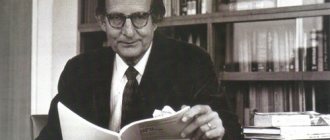Eysenck was a prominent and polarizing figure in British psychology, known for the vast scope of his research and the outspoken, often controversial views he expressed. He developed a distinctive dimensional model of personality based on factor analytic summaries and biogenetic processes. Eysenck combined descriptive statistics with physiological experiments, breaking down the distinction between pure and applied science. He was an outspoken proponent of the biogenetic basis of individual differences in intelligence and personality, and a fierce critic of psychoanalytic psychotherapy. Eysenck, the author of eighty-five books and more than a thousand scientific papers, was a famous popularizer of psychological science.
Life and Career
Eysenck was born an only child in Berlin in 1916. His mother, Ruth Werner, was a famous silent film actress (with the stage name Helga Molander) in the early years of the German film industry, and his Catholic father, Eduard Eysenck, was a stage performer. Shortly after his birth, his parents divorced and he was raised by his Jewish maternal grandmother. Eysenck graduated from high school at the Prinz-Heinrichs-Gymnasium in Berlin in 1934. However, his ambiguous ethnic background left him with a difficult choice: he could either follow the National Socialist line or leave. His mother and her partner, Jewish film producer Max Glass, had already fled to France. Eysenck decided to join them, spending several months in Dijon in the summer of 1934 before traveling to London in August. His father Edward remained.
Winter 1934–1935 Eysenck took intermediate courses at Pitman College in London and then applied to study physics at University College London in October 1935. However, he found that he lacked the necessary prerequisites and enrolled in psychology instead. After receiving his degree in 1938, Eysenck remained at University College and quickly completed a doctorate on the experimental analysis of aesthetic preferences under the supervision of Cyril Burt. The war escalated when Eysenck defended his doctorate in June 1940. As a German citizen, he narrowly escaped internment. As restrictions eased, Eysenck was given a job at Mill Hill Hospital in north London in June 1942. After the war, the Maudsley Hospital was re-established in South London and merged with Bethlem Hospital. A new Institute of Psychiatry in London was added as a teaching and research center for postgraduate students. Eysenck rejected offers from several other universities to head the psychology department. This was his first and only job, providing a stable institutional environment until his retirement in 1983. He was given extraordinary bureaucratic freedom to organize the department according to his research priorities. In 1938, Eysenck married Canadian graduate student Margaret Davis, and they had one child, Michael Eysenck, born in 1944, a renowned psychologist in the early 21st century. The marriage, however, took place soon after the war. In 1955, Hans Eysenck became a professor of psychiatry and a British citizen.
Studies
He received his education in European private schools. Often loving to demonstrate his superior knowledge over teachers who graduated from military universities, he was also superior to many physically. So, after he expressed his disapproval of fascism and Hitler in particular, the school staff beat him up with almost the entire staff. However, his answer to the offenders was also not long in coming. The teachers had difficulty hushing up the scandal, which threatened to turn into a massacre.
After graduating from high school, he was accepted into the Faculty of Philosophy at the University of Berlin. However, there they persistently hinted at the need to join the SS, so his mother and stepfather (a Jewish director) decided that it would be better to leave the country. At the University of Dijon, in France, he studied history and literature, and the next year he entered the University of London, in England. There Eysenck asked to study at the Faculty of Physics, but after a course in history and philosophy he could only be accepted into psychology. He agreed to agree, but caused quite a scandal in the process.
Thanks more to his ability to talk on any topic and self-confidence than to actual knowledge, he graduated from the university with honors and received a red diploma. Professors dubbed him “the hope of future science” and gave him good recommendations, and several private colleges even invited him to give lectures.
Scientific activity
A number of Eysenck's studies were perceived as "shocking"; their themes, quite normal for Nazi Germany, seemed unacceptable in Europe. In particular, he examined psychological differences between representatives of different races. American wholesale and retail booksellers refused to distribute Eysenck's The IQ Argument (1971) due to threats of violence and arson, making it impossible to purchase the book in the United States in the early 1970s. American newspapers in those years refused to publish reviews of it.
Eysenck began his studies of basic personality traits with an analysis of the results of a psychiatric examination of a contingent of soldiers - groups of healthy people and those recognized as neurotic. As a result of this analysis, 39 variables were identified in which these groups turned out to be significantly different and factor analysis of which allowed us to obtain three factors, including the factors of extraversion-introversion and neuroticism (“Dimensions of Personality”, 1947). As a methodological basis, Eysenck focused on understanding the psychodynamic properties of personality as determined genetically and ultimately determined by biochemical processes (“The Scientific Study of Personality”, 1952). Initially, he interpreted extraversion-introversion based on the relationship between the processes of excitation and inhibition:
- extroverts are characterized by the slow formation of excitation, its weakness, and the rapid formation of reactive inhibition, its strength and stability;
- for introverts, the rapid formation of excitation, its strength (this is associated with their better formation of conditioned reflexes and their rapid learning), and the slow formation of reactive inhibition, its weakness and low stability.
As for neuroticism, Eysenck believed that neurotic symptoms are conditioned reflexes, and behavior that represents the avoidance of a conditioned reflex stimulus (danger signal), and thereby eliminating anxiety, is valuable in itself.
It should be noted that Eysenck rethought the terms extrovert and introvert, introduced by C. G. Jung - initially they had a different content.
In his work “The Biological Basis of Personality”, 1967, Eysenck proposed the following interpretation of these two personality factors:
- a high degree of introversion corresponds to a decrease in the activation threshold of the reticular formation, therefore introverts experience higher arousal in response to exteroceptive stimuli;
- and a high degree of neuroticism corresponds to a decrease in the activation threshold of the limbic system, therefore, individuals with high scores on this scale have increased emotional reactivity in response to events in the internal environment of the body, in particular to fluctuations in needs.
As a result of further research using factor analysis, Eysenck formulated the “three-factor theory of personality.”
Three Factor Theory of Personality
The three-factor theory of personality is based on the definition of personality traits as a way of behavior in certain areas of life:
- at the lowest level of analysis, isolated acts in specific situations are considered (for example, the currently manifested manner of entering into a conversation with a stranger);
- at the second level - frequently repeated, habitual behavior in essentially similar life situations; these are ordinary reactions diagnosed as superficial traits;
- at the third level of analysis, it is discovered that repeated forms of behavior can be combined into some meaningfully uniquely defined complexes, first-order factors (the habit of being in company, the tendency to actively engage in conversation, etc. give grounds to postulate the presence of such a trait as sociability);
- finally, at the fourth level of analysis, meaningfully defined complexes themselves are combined into second-order factors, or types that do not have an obvious behavioral expression (sociability correlates with physical activity, responsiveness, plasticity, etc.), but are based on biological characteristics.
At the level of second-order factors, Eysenck identified three personality dimensions: psychoticism (P), extraversion (E) and neuroticism (N), which he considered genetically determined by the activity of the central nervous system, which indicates their status as temperamental traits.
In the vast number of applied studies that Eysenck conducted to prove his theory (most often, together with specialists in the relevant fields), the importance of differences in these factors was shown in crime statistics, in mental illness, in susceptibility to accidents, in the choice of professions, in the severity of the level of achievements, in sports, in sexual behavior, etc. Thus, in particular, it was shown that according to the factors of extraversion and neuroticism, two types of neurotic disorders are well differentiated: hysterical neurosis, which is observed in persons of choleric temperament (unstable extroverts) , and obsessive-compulsive neurosis - in people of melancholic temperament (unstable introverts). He also conducted numerous factor-analytic studies of various psychological processes: memory, intelligence, social attitudes.
Based on the “three-factor model of personality,” Eysenck created the psychodiagnostic methods EPI (“Manual of the Eysenck Personality Inventory”, jointly with Sybil BG Eysenck, 1964) and EPQ [1] (inaccessible link), which continued a number of previously created ones (MMQ, MPI ( "Manual of the Maudsley Personality Inventory", 1959)).
Three-phase theory of the emergence of neurosis
Eysenck is one of the authors of the “three-phase theory of the emergence of neurosis,” a conceptual model that describes the development of neurosis as a system of learned behavioral reactions (“The Causes and Cures of Neuroses,” jointly with S. Rachmann, 1965). Based on this behavioral model, methods of psychotherapeutic personality correction were developed, in particular, one of the variations of aversive psychotherapy.
Basic concepts of Eysenck's theory
Eysenck the psychologist worked on the study of personality. In his view, it appears as a complex hierarchical structure.
The hierarchy of personality can be traced from a person’s simple reactions to repeated situations to the type of his temperament. An example of this would be communication between people. A person may respond without enthusiasm to other people’s suggestions to spend time actively. At the same time, he always maintains his distance and prefers solitude. This speaks of his unsociability. But in general, both of these parameters may indicate introversion.
Personality and politics
Eysenck extended his early success in gaining control of personality through factor analysis into the political sphere. Although he subsequently published several more articles, his 1954 book The Psychology of Politics remained his major statement in the field. Eysenck summarized social and political relations with two bipolar dimensions. One dimension made the usual distinction between radicalism and conservatism, and the other contrasted hardness and tenderness, following the thinking of William James. This led to the creation of a four-quadrant space, the most provocative consequence of which was that the extremes of fascism and communism were separated by ideology but similar in terms of personal style. For Eysenck, this balanced the political picture, explaining the “same but different” paradox he saw in pre-war Germany. His work clashed directly with post-war studies of the authoritarian personality, with Eysenck controversially arguing that Theodor Adorno and his co-authors' measure of fascist potential in The Authoritarian Personality (1950) was virtually synonymous with rudeness. This led to a contentious, highly technical debate with Milton Roach and Richard Christie about the reality of left-wing authoritarianism in Western democratic societies.
Becoming a scientist
What contribution did Eysenck Hans Jürgen make to science? Currently, few people think about the emergence of such familiar concepts and phenomena. However, some of them began to exist not so long ago. Eysenck watched with bated breath, as far as possible, the genetic experiments carried out at Ahnenerbe. The young scientist had the opportunity to conduct brain research himself with the intention of identifying a correlation between brain size and human intelligence. Such experiments have so far not led anyone to establish any patterns, but Hans needed to make sure of this.
Intellectual differences
Eysenck's public reputation has recently been overshadowed by his popular writings on intelligence - although he came to it late as a research topic - because these reflections touched on some sensitive areas of public interest. In the late 1960s, as his four children from his second marriage were starting secondary education, the British government envisioned major reforms aimed at straightening out the tripartite structure of the secondary school system. Eysenck quickly identified himself as an enemy of these reforms and further argued that compensatory measures, such as more money for facilities and teacher salaries in poorer regions of the country, would be ineffective or even counterproductive for those targeted. He raised his profile even further with his 1971 book supporting Arthur Jensen's claim that black-white differences in IQ scores were partly heritable. While Race, Intelligence and Education was poorly received by many of his peers, the groups' vehement protests showed that Eysenck had emerged as a symbol of freedom of scientific expression.
However, the public harassment he suffered was enough to ensure that he largely avoided discussing the issue of race.
The Cyril Burt scandal in the mid-1970s, in which Burt was accused of producing data showing that intelligence was inherited, brought Eysenck back into the nature versus nurture debate. In the end, he reluctantly distanced himself from the dubious practices of his old mentor, but not from his general ideas. Eysenck might have reiterated his claim that intellectual differences were 80 percent heritable—a high-level estimate in the field—most notably defending this position in a 1981 confrontation with Leon Kamin, co-author of The Intelligence Debate. In the latter part of his post-retirement career, Eysenck also played a key role in efforts to increase intelligence using vitamins. In some ways, he even suggested that nutritional factors may be responsible for racial differences.
Eysenck's research on intelligence began only in the late 1970s, when Eysenck also played a leading role in defining concepts and leading debates. Throughout his career he remained committed to the concept of general intelligence, or g , created by his intellectual ancestor Charles Spearman . True to his London School view, Eysenck focused on individual differences rather than components of intelligence. He attempted to avoid the circularity of psychometric definitions of intelligence by looking beyond IQ tests to explore the relationship between intellectual differences and central nervous system functioning.
In the early 1980s, Eysenck encouraged psychologists to take another look at Francis Galton's (1822–1911) contention that processing speed was an important factor in intellectual differences. Eysenck advised that reaction time and electroencephalogram (EEG) measures of brain activity showed great promise. However, Eysenck's own EEG research in the early 1990s was extremely disappointing, and the biological basis of intelligence remained a work in progress. Speed was an important but not decisive factor, and Eysenck suggested that it was a by-product of more efficient, error-free neural transmission.
Deviation from the norm
Eysenck poses another problem: the increase in mental illness in society in geometric progression. And does psychotherapy solve its problems in this case? After research, it turned out that 2/3 of neurotic patients recover both after a course of psychotherapy and while in psychiatric hospitals (undergoing drug treatment). Does this speak in favor of psychotherapy? No. Although you shouldn’t underestimate her either.
In this part of the work, Eysenck's criticism of psychoanalysis is especially interesting. No, he is not inclined to completely abandon the achievements of S. Freud - after all, the discovery of the sphere of the unconscious, work with childhood traumas, defense mechanisms, suppressed desires - all this has a rational grain and had a great influence on the development of psychology as a science. “I would not like the reader to think that I am an ardent opponent of psychoanalysis in all its manifestations. Like many other psychologists, I appreciate the breath of fresh air that Freud breathed into the stale, dry atmosphere of 19th-century academic psychology. The genius of his mind opened the doors to a new world for us, and his unusual insight gave us many interesting theories and hypotheses that researchers will ponder for a long time. Of course, many of Freud’s ideas are important, but this does not mean that we should agree with him in everything and perceive his theory as some kind of revelation from above” [1, pp. 230-231]. Psychoanalysis was originally concerned with deviations from the norm - Freud studied, first of all, neurotic patients.
However, he believed that the root of the pessimistic personality was that weaning occurred too early. As Eysenck shows, there is a correlation, but it can be assumed that depressed mothers give birth to depressed children, and such mothers wean their children early. What prevails: heredity or environment remains an open question.
What, according to Eysenck, are the shortcomings of psychoanalysis?
- Unscientific approach. “Psychoanalysis tries, rather, to understand than to explain, which means that it is not scientific and should be approached from a position of faith, and not from the position of evidence and scientific justification” [1, p. 215].
- Level of argumentation. “The evidence is mainly clinical, not experimental” [1, p. 218]. And if in clinical cases some manifestations are natural, is this in the nature of typification? And is this true for normal individuals, without pathologies? At the same time, the argumentation is not systematic, which is also an important drawback. The absence of a control group entails subjectivity of conclusions, often to please the therapist.
- Strong emotional connection between client and therapist. This leads to inevitable distortions and introduces a lot of subjectivity.
- The blurring of Freud's hypotheses. And therefore – their invulnerability to criticism. “Psychoanalysts overgeneralize their conclusions” [1, p. 226].
- Claim for versatility. “Psychoanalysts apply their principles to social phenomena in general, although the fact of their applicability in this case has not been proven” [1, p. 226].
- Artificiality of arguments. “Psychoanalysts adjust facts to suit their arguments” [1, p. 228].
Eysenck's conclusion: “Instead of experimentally verified conclusions from clearly formulated hypotheses, we find only anecdotal evidence collected rather randomly from individual case histories. This lack of reliable evidence is often hidden from the reader by Freud's excellent writing skills, for which he was deservedly awarded the Goethe Prize for Literary Achievement in Germany. However, in science, persuasion should not replace evidence, and we should examine Freud's demonstrative efforts more carefully before concluding about the reliability of his hypotheses" [1].
Personality, smoking and illness
Eysenck's other important initiative after his retirement was to study the relationship between temperament and physical health. In the early 1960s, a collaboration with oncologist David Kissen suggested a link between cancer and personality. Eysenck soon attracted more attention by stating that the causative role of cigarettes in cancer had not been convincingly proven. Eysenck received a boost of criticism from public health advocates as the anti-smoking message became more visible and compelling in the late 1960s.
Eysenck revisited the issue in the early 1980s and presented new genetic evidence linking personality, smoking and disease. In a series of papers in the late 1980s and early 1990s, Eysenck and the little-known Yugoslav researcher Ronald Grossart-Maticek reported a series of longitudinal studies apparently demonstrating a striking link between personality types and cancer and coronary heart disease. Although Eysenck did not organize these studies, his contributions helped fine-tune the presentation and analysis. There have been a number of interventions suggesting that psychotherapy can have surprisingly beneficial effects for cancer patients and people with unhealthy lifestyles. While the scope and ambition of these investigations was welcomed, critics complained of a lack of methodological control and descriptive detail. Some, such as Anthony Pelosi and Louis Appleby, even suggested that the results were "too good to be true."
Special works
Hans Jürgen did not ignore such a sensitive topic as criminal behavior. In 1964, the book “Crime and Personality” was published. There is not even a hint of the famous Lombroso theory in it. According to Eysenck, individuals with high levels of extraversion, neuroticism and psychism, due to the costs of socialization, can become criminals. The author put forward a hypothesis about the presence of a “criminal class” group in the population. It is worth noting that this work caused a lot of criticism and controversy in the scientific community, but it also acquired followers.
Popular books
Over the years, Eysenck created a number of extremely popular paperback books and made numerous media appearances. He was the people's psychologist in Britain; his bestselling Pelican books in the 1950s and 1960s helped introduce the discipline to many future students. Eysenck's strict empiricism was accompanied by a skepticism that entertained almost everyone except those he counted on. Eysenck's Race and IQ were an extension of this popular role, a deliberate provocation of his liberal critics. Yet it polarized his reputation to such an extent that it stalled his career as a major spokesman. After this, Eysenck tended to turn to more unusual topics for both serious research and popular presentations, including gender issues, sex and marriage, parapsychology and astrology. The latest set of essays on genius, creativity and madness.
Hobbies of Ph.D.
The biography of Hans Jurgen Eysenck tells the story of his passionate youthful interest in astrology. Naturally, he approached this issue with all the seriousness of a research scientist. The study of astrological charts was carried out with the same goal: to find a pattern that contributes to the development of talent. While studying the topic, Eysenck corresponded with many famous astrologers. He drew up and mailed cards to some representatives of the Reichstag warning them of the collapse of all their plans. But there was no answer.
Observations of fascism and the radical left led the scientist to the conclusion that these groups are more similar than different. Both had an authoritarian management style, rigidity and intolerance of dissent, in contrast to the control group. Perhaps this hypothesis only strengthened the scientist’s belief in the importance of the biological component in the nature of intelligence.
Legacy and wider influence
Eysenck's three-dimensional view of personality has always been countered by more complex descriptive systems in the United States, particularly Raymond Cattell's sixteen personality factors. However, Eysenck never compromised his view that three dimensions were sufficient to describe the basic, culturally universal structure of personality. The physiological aspects of his work alienated social psychologists, while experimentalists did not appreciate his insistence on incorporating individual differences in their search for underlying mechanisms. Few researchers have shared its integrative approach. Several serious challenges arose within this tradition, especially from his successor Geoffrey Gray.
Without qualifications, Eysenck was the most influential psychologist in post-war Britain. Yet he received belated recognition in the United States and was never truly honored in his homeland. His supporters recalled that in many ways he was a foreigner—too ambitious, too nonconformist. A pronounced introvert, Eysenck was not interested in more conventional forms of social networking. He refused to dominate or modernize existing disciplinary bodies and instead created his own. People joined him, not the other way around.
Eysenck trained hundreds of research students. They were the key to his enormous result, co-opted into an all-encompassing, programmatic setup. Many subsequently took up key positions at universities in the UK and abroad. Although he did not want the idea of a dogmatic "Eysenck school" to be promoted, his ideas and approaches continue to develop in the hands of an international network, centered on journals such as Personality and Individual Differences and the International Society for the Study of Individual Differences - all of which Eysenck was fundamental in the creation.
If you find an error, please select a piece of text and press Ctrl+Enter.
How to take the test
To pass the Eysenck personality test, you need to answer the questions below, and then use the key to decipher the answers. It is worth noting that the questions posed must be answered unambiguously (negatively or affirmatively). In addition, do not think about your answer, immediately indicate “yes” or “no”.
So, the key to the test will be the following answers that match the specified values:
In order to process the responses, you need to evaluate them. For answers that match the key, 1 point is given. Thus, having calculated the results, you can analyze the data:
- On the extraversion scale: a bright extrovert will receive more than 19 points, an extroverted personality will receive more than 15 points, the average value of extraversion will be 12 points, a deep introvert will have less than 5 points and less than 9 for a simple introvert.
- On the neuroticism scale: a score of 19 or more is considered very high for neuroticism. Those who scored more than 14 had a high level of neuroticism. The average value of neuroticism varies between 9-13 points. And a low level - when the respondent got less than 7 points.
- On the “lie” scale: the acceptable value for this scale is 4 points. If the test taker managed to score more than 4 points, then this indicates the individual’s tendency to consciously lie for the sake of universal approval.
Dream interpretation
This chapter literally repeats the title of Freud's work. “According to the theory of Freud and many others...dreams do not reveal anything about the future” [1, P. 438]. And they are dedicated exclusively to the past and present, in symbolic form. Here, too, one cannot do without a critical approach to psychoanalysis: Freud believed that in a dream everything has meaning (but this idea existed in culture for a long time, and he only popularized it), everything is connected with the satisfaction of desire (and this is also not original), and consciously suppressed (and only this thought is truly Freud’s discovery (see: [1, p. 439]). And the method of verbal associations, as Eysenck proves, is rather a discovery of F. Galton. In addition, the legitimacy of the symbolic interpretation of dreams has not been proven ( Thus, Hall argued that the same action causes different reactions and associations in different people).








